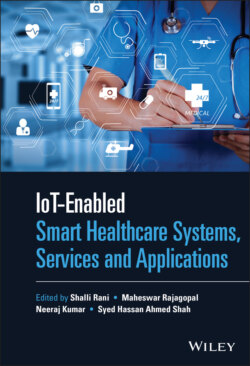Читать книгу IoT-enabled Smart Healthcare Systems, Services and Applications - Группа авторов - Страница 14
1.1 Introduction
ОглавлениеEnvironmental pollution is an important factor that affects the health of every age group. Health improvement is an urgent need to improve quality of life. Owing to the advancements in computation and communication technologies, the healthcare sector has benefited handsomely from the available tools and applications [1]. Healthcare‐related actors (doctors, facilitators, practitioners, researchers, and strategic planners) are striving to address the challenges faced by the current healthcare system by continuously struggling with the healthcare system performance. Till date, a plethora of smart tools pertaining to electronic healthcare are used. It is important to note that the healthcare enhancements enable a positive change to become smart healthcare. Sufficient access to healthcare is related to an increment in life expectancy of about 2.0–2.5 years in men and women at age of 65 as reported in China [2]. Many of the research directions at the emergence of data analytics, wireless communication, information security, intelligent networks, and AI‐equipped methods that provide early diagnosis, prevention, and constant treatment of health conditions. These new technologies and techniques are visualized as the basic elements of modern healthcare. Gunther Eysenbach indicated that healthcare is to be improved worldwide and locally with the utilization of information and communication technology [2]. The deliverance of smart healthcare depends on groups of instructed caregivers and emerging technology mediums. Healthcare systems that are routinely used nowadays were not long ago just a vision beyond our technological frontier. Therefore, the emergence of technology and digital systems (consisting of many heterogeneous sensors and computing devices) has created a chance to transform traditional healthcare systems with Internet‐based systems to harness the benefits of cutting‐edge technologies. Smart healthcare leverages these new emerging technologies to transform the traditional medical measures. The patient will experience better care, and they are fundamentally changing how medical decisions and treatments are rendered. Technology is playing a significant role in the vital fields of medicine and targets the services of smart healthcare in three different sectors: clinical institutions, regional health institutes, and individual family members. These entities are interconnected through applications that consist of virtual assistance, smart health centers, patient diagnosis, and patient treatment. Deloitte indicated that technologies such as nanotechnology, genomics, blockchain, augmented reality (AR), additive manufacturing, robotics, and cognitive computing made medical care less expensive and more versatile for caretakers and patients. The report also indicated that new devices (both handheld and wearable) make it possible to collect the patients’ data remotely in an efficient way [3].
The evolution of these technologies has opened new opportunities and possibilities in the field of healthcare. Armando observed the adoption of smart healthcare monitoring devices in India and pointed out that the cost varies according to the features and design of the device. Despite this it is investigated how these devices can have a remarkable effect in developing countries that have reduced treatment cost and patient time at the same level [5].
The rising trend of remote healthcare allows for a timelier administration of treatment for patients at their homes, significantly reducing the cost of intervention as well as improving the quality of care with personalized technologies. The patients can decide whether or not to further consult healthcare professionals. The automated computational readings of smart devices refer consultation of a physician to seek emotional support and inpatient care. For personalized care, patients may also use applications to detect a correspondence between the condition and medication interactions to make the decisions on how to improve their health. Furthermore, for more in‐depth testing, patients may also decide to use home kits or personalized genomic services. Smart healthcare technology consists of different components such as sensors, smart pills, smart surgeries, wearables, and registration devices. Remote technologies may help healthcare professionals to provide fast and better care.
Technologies such as cloud computing, artificial intelligence (AI), 3D printing, Internet of Things (IoT), 5G, and blockchain revolutionized our physical world by doing a digital replacement of real‐world objects with virtual ones. In this chapter, we discuss the role of emergent technologies (such as AI and blockchain), their usage, and applications in smart healthcare. AI is leveraged to make predictions based on the learned patterns and experience of the machines. 5G is another emerging technology, which is currently in its commercialization phase. Similarly, blockchain, a distributed ledger, is used for data and transaction transparency as well as immutability. Once the data has been recorded in the blockchain, it becomes immutable. Shou [1] indicated that the problems of existing smart healthcare are not only dependent on technological advancement but also a joint venture of doctors, patients, and health institutions related to cost reduction, management of diagnostics and data, which improves patients’ feedback. Yin et al. [6] discuss implantable and wearable medical devices that gather physical signals from anywhere and anytime, which are based on IoT and machine learning. The world is facing numerous health crises in case of surgeries, treatments, and ever‐increasing demands of medicines, but all of these crises will be tackled by the emergence of smart care technologies in the health sector.
